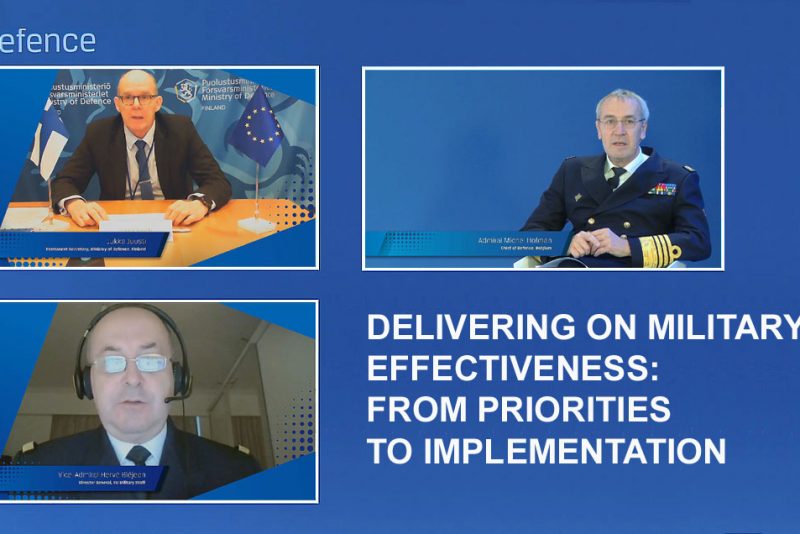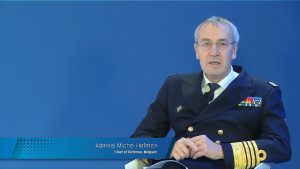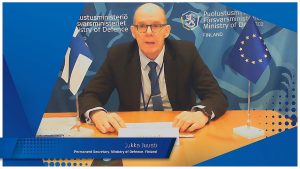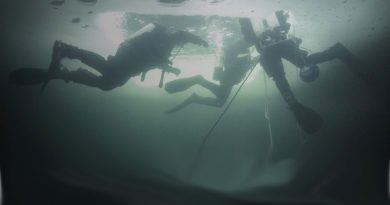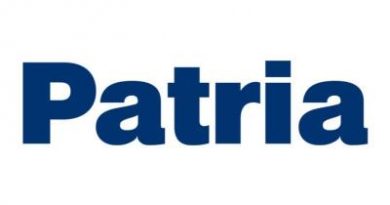Delivering on Military Effectiveness: from Priorities to Implementation
Following the opening speeches it was time for the first roundtable, which topic was “Delivering on Military Effectiveness: from Priorities to Implementation”. Moderated by Dr. Daniela Schwarzer, Director, German Council on Foreign Relations, it aligned three panellists, Mr. Jukka Juusti, Permanent Secretary, Ministry of Defence, Finland, Admiral Michel Hofman, Chief of Defence, Belgium and Vice-Admiral Hervé Bléjean, French Navy, Director General, EU Military Staff. The question that confronted them was, “How key capability areas on which Europe is focusing on, in order to support both crisis management and the protection of European citizens and territory, will translate into national programmes?”
Underlining the importance of EU defence for Belgium, Adm. Hofman stated that cooperation is in the Belgian military DNA. This will probably increase as the country has a new government, which has a pro-EU stance; the new Minister of Defence, Ms. Ludivine Dedonder, provided political orientation for the next four years in which the EU takes a prominent role. “Probably for the first time the importance of the EU security and defence has been highlighted with so many words in political documents,” the Belgian CHOD said, adding that in official documents, “The EU strategic autonomy, the EU position as a strong pillar in NATO, the importance of the EU strategic enablers, that of the Military Planning and Conduct Capability (MPCC), PESCO commitments, and the EU shortfalls mitigation through projects also helped by the EDF,” appear many times. At Belgian defence level, cooperation and multilateralism, mostly with NATO and the EU, is part of the policy, and this can be found in the national Strategic Vision 2030 document. “For capability development we have a capability management division in the Defence Staff which takes into account national but also multilateral planning considerations, such as NATO targets, EU capability shortfalls and priorities,” Adm. Hofman explained. This goes into the National Integrated Capability Development plan. However cooperation goes further, Belgium looking almost automatically at cooperation with partners on important capability projects. This can also extend to training, education, maintenance and even to an operational dimension. Of course Belgium preferred natural partners are those nations that are geographically close to it, the main cooperation projects being currently the investment in the MultiRole Tanker Transport (MRTT), naval programmes as the cooperation between the Belgian and Dutch navies dates back almost 30 years, the Capacité Motorisée(CaMo) programme with France for new armoured wheeled vehicles, and many other within Benelux. Admiral Hofman also states that the Integrated Capability Development plan already fulfils some of the capabilities expressed in the High Impact Capability Goals (HICGs) and in EU CDP priorities. He also underlines that Belgium is taking part into 11 PESCO projects, and has an observer status in five more. “Among those, Military Mobility is especially relevant for Belgium, which is a transit country, Belgium having also the lead in the Maritime (semi-) Autonomous Systems for Mine Countermeasures (MAS MCM),” he adds, before stressing the importance for the EU to establish a leading role in disruptive technologies, fields such as information dominance and cyber knowledge being also of importance, a European approach allowing affordable access to these valuable assets also to smaller Member States.
VADM Hervé Bléjean, the Director General of the EU Military Staff, started his speech underlining that the CARD was presented to the Ministers of Defence in a moment where the Union is promoting cooperation through a dedicated set of initiatives, while at the same time Member States are encouraged to exploit cooperation to face the COVID crisis. “Connecting CARD only to cooperation would not grasp its full potential,” he said, “As it develops into broader strategic and political frameworks, portraying a comprehensive view of the European security and defence landscape.” The report portrays a fragmented security and defence capability landscape and highlights some limited political will to engage and sustain military efforts on the field. “This becomes evident when we consider the force generation problem we are continuously facing,” the EUMS DG explains, adding that looking at numbers is sufficient: considering 2018 figures in terms of number of soldiers employed by Member States in military EU operations, this represents only 7% of the total effort, which includes a much larger participation to NATO activities or to national operations.
The document is not only describing facts, it also analysed root causes, VADM Bléjean said, highlighting that the EU needs to overcome its built-in differences in perceiving the security and defence environment. “We need to achieve a deeper European strategic culture that will sustain higher and common ambitions for cooperation, both in building capabilities and in expressing credible and substantial operations.” The EUMS identified three priority areas for operational collaborative opportunities focusing on identified capability shortfalls that cannot be adequately addressed by single Member States alone: Force Projection, i.e. aircraft carriers and amphibious capabilities, Non-Kinetic Engagement Capabilities, including cyber effects and strategic communication, and Force Protection, including high-end ballistic missile defence. This will allow improving EU capabilities in order to fulfil the Union LoA.
This can be reached through the EU Headline Goal Process, which in the last two years was reshaped into a cycle, aligned with the corresponding NATO process. “It has been adapted to the new EU Defence Initiative, and delivers as a final outcome a set of HICGs specifically designed to achieve the political LoA through a phased approach in the short and medium term, VADM Bléjean explains. He also underlines the need to establish a link between the planning and the development of those military capabilities, “And this is where HICGs merge into the CDP, the PESCO projects, the EDF and national programmes for capability development,” the EUMS Director said. All those activities aim at delivering capabilities, Member States being the real producers and EU institutions functioning as cooperation promoters. Concluding his initial speech VADM Bléjean states that the EUMS will fully support the Strategic Compass, which is of importance for the military, as it will provide further guidance for future military planning. “We are looking at implementing the Strategic Compass outcome through the next Headline Goal Process which will start with the new multiple guidance at the beginning of 2023.”
Technical problems having been solved, it was time for Mr. Jukka Juusti, Permanent Secretary, Ministry of Defence, to express his views. “Implementing and delivering is what we need to do. At some point we will need new instruments and policies, but let us start by implementing the existing ones,” he states. Considering the position of Finland, Mr. Juusti stresses the importance that the CDP addresses the military capabilities required for territorial defence in addition to the expeditionary operations. “In the long run European and national priorities will gradually converge. At this point we must make sure that regional differences and specific requirements are recognised,” he said. He mentioned as limiting factor to some areas of cooperation the fact that Finland is located at the periphery of the EU area, and has a long external border with Russia, the country being surrounded by the Baltic sea on most of the remaining borders; “Sometimes the most viable solution for us are national options.” He however recognizes that some complex and expensive capabilities can be reached only through cooperation. He then looks at two of the CARD focus areas. The first is Counter-UAS, which can be viewed from two different perspectives, according to the Finnish representative, first Crisis Management Operations, and second the protection of the European territory. Countering commercial UAS is the likeliest scenario, while military unmanned air systems are the probable threat regarding the territorial defence in time of crisis. These two different scenarios entail capabilities that have different requirements and technical features, which need to be specified at an early stage. Coming to the other focus area Mr. Juusti said that, “Defence in space is a good example where a collaborative approach is needed in order to have access to required capabilities.” In his final point he emphasised that for Finland an important pillar of resilience is the mutual assistance clause, Article 42.7 [1] of the Treaty on European Union. “This is a tool that was created for the purpose of protecting Europe, and we need to strengthen this tool with adequate capabilities.”
The first question relied on what has to be done in terms of cooperation among Member States to get closer to that EU strategic culture evoked by the EUMS Director General. “It is probably an effort that all of us have to do in our own countries, although incentives might come from the EU, and the work which is being done on the Strategic Compass is probably a good one to foster all those efforts to improve the culture in general in our countries,” Adm. Hofman, the Belgian CHOD said. “Before building the strategic vision, we must build the common understanding of what are the threats and challenges,” VADM Bléjean states, “and in that respect I think we have achieved a major interesting step to base the strategic discussions of the Strategic Compass upon the delivery of the threat and challenges analysis, that has been done by the Intelligence Services of the EU, both in the EUMS and in the INTCEN (Intelligence and Situation Centre), which is led by civilian authorities.” The 360° view is not necessarily an agreed view, but it is the result of the gathering of what the Member States provided, VADM Bléjean considering it a success, which in fat it is, as until not long time ago sharing intelligence was a touchy issue, even among NATO allied. While no details can be unveiled, the Compass being a classified document, the EUMS DG said that the reports that came from 50 national intelligence agencies of 26 countries were converging much more than expected, and this should be a solid base on which building the political discussion. “I think that this will give the momentum to deliver a new strategic guidance for all EU military and civilian engaged in operations.”
Cooperation and coordination is very much stressed when talking about equipment; what is happening in the personnel area? How EU forces personnel manage to share experiences, know how, and to better know each other, to reach the aforementioned common culture? Dr. Schwarzer first turned the audience question to VADM Bléjean.
“A lot of things are already in place. Having a lot of personnel in the same missions and operations helps to build what we might define ‘human interoperability’ that we need to build that common understanding. Looking at the EU Training Mission in Mali, 22 Member States are part of it, which means that on the field all of them are sharing the same way to deliver the training mission to the host nation. This also attracts some partners, and I think that discussions between EU personnel, military and civilian, and partners, allows to further spread the values that the EU is bringing,” the French Officer said. The EU also established the the European Security and Defence College which provides a number of courses as well as developments of common syllabus for education of Officers and NCOs. According to the EUMS DG the best way to reach personnel interoperability is to go out on the field and share experiences and values. “The more we solve the force generation issues by sending people out there, even one or two of them, the more that contribution will allow them to bring back that shared experience,” he concludes adding that the EU ‘human interoperability’ must be compatible with the NATO one, therefore a permanent discussion is ongoing with the Alliance on personnel issues to make sure the two organisations deliver the same way to educate and train.
“We explored the personnel domain from a different perspective,” Adm. Hofman explains bringing the Belgian view to the problem. “Since over 10 years the Belgian Defence is open for any EU citizen. Any young European can join the Belgian Defence; we have not recruited high numbers of European citizen, but we do have examples not only of French personnel but also Dutch personnel in our Armed Forces, as well as some Romanian, Bulgarian, and citizen from other European countries serving in our Defence organisation, even though they do not have a Belgian passport but a European passport.” This was done also to partly solve the recruitment issue, which is often a problem for countries with a high level of life and a small population. “Another approach is the one we built between the Belgian and Dutch navies. We have been thinking a lot about not only the exchange of personnel but also mixed crews on board our ships,” Adm. Hofman said. That decision was postponed for some time, but now it is possible to regularly find Belgian personnel on board Dutch ships and vice versa. “This allows to fill gaps, the next step being that of mixed crews, with a Belgian-Dutch flag,” he adds but there some touchy issues would have to be solved first, sovereignty being the main one, but other legal problems such as salaries having also to be considered. “I would add that within EU structures, such as the EUMS, our people can cooperate, and we also have EDA training programmes where personnel of different Member States works together,” Mr. Juusti said, highlighting that at local level there is a lot of cooperation, especially between Finland and Sweden, which air forces perform cross-border training on a weekly basis, stressing however that more cooperation is needed at European level.
Picking up a further question from the audience, Dr. Schwarzer put on the discussion table the issue of the exact definition of ‘Strategic Autonomy’, around which a debate, not only among European Union members but also from the two sides of the Atlantic Ocean, is currently ongoing. Is there a common understanding of that definition?
“I would like first to underline that the expression ‘Strategic Autonomy’ is an expression that was taboo until five years ago, and now is part of the common language of EU institutions and of the EU CSDP vocabulary,” VADM Bléjean said. He admits that asking Member States a definition of Strategic Autonomy, answers will be probably as numerous as the number of countries. “In my view the Strategic Autonomy is the ability for the EU to act as a collective body in the field of defence and security, to protect EU citizens inside or outside the European borders,” he adds, saying also that for EU/NATO members the Atlantic Alliance Article 5 [2] remains the pillar of that collective defence, but as underlined by Mr. Juusti not all EU Member States fall under that umbrella, his country, Finland, being an example. “The operalisation of Article 42.7 is a guarantee that the EU has to offer to these Member States,” the EUMS DG states, highlighting that the Transatlantic Relationship is seen from the two sides of the Ocean considering each one its own interests, so Allied support to an action carried out by the EU to guarantee its own security would not be automatic. “We are in Africa with our training missions in Mali, Somalia, Central Africa, and this is not a place where NATO has developed any operational mission, even if some of the NATO member nations are there,” VADM Bléjean explains, “So the ability to have this common will to act collectively as a EU body for the security of our citizens, without the need of any further support, is what I consider a definition for ‘Strategic Autonomy’,” he concludes.
“My answer will go in the same flavour of VADM Bléjean,” Adm. Hofman starts his remark, “It is the ability to decide autonomously what you want to do, and to create the desired effects in the operation, with available tools. These tools are the capabilities that are being developed, and I think it is an illusion for the EU to develop all capabilities required in all scenarios, without having the support from our NATO friends and Allies. However I do think that in many scenarios Europeans can go further in autonomy and independency of decisions at strategic level.” The Belgian CHOD underlines that this is a common goal for all European countries, and it is something that has to be shared with EU partners. Among those we find transatlantic ones but not only, Adm. Hofman remembering that 20 miles away, across the Channel, the United Kingdom has military capabilities that could also help in many crisis scenarios, albeit the UK is not anymore part of the EU following its BREXIT decision.
Elaborating on Strategic Autonomy Mr. Juusti adds that, “We are very interested in the European security of supplies and there are some commitment missing, therefore some issues have to be considered at national level. We very much welcome the Strategic Compass initiative, but in our view the security of supplies should be first addressed.”
Concluding the remarks, Dr. Schwarzer highlights how, following the US elections, the debate has changed and the United States are less critical about the use of the Strategic Autonomy wording, acknowledging that some reliant Europe, whatever the term is, could be helpful.
Which might be the implications of building a European Pillar within NATO in respect to defence capabilities developments in the EU? What does this mean from a practical standpoint? How the NATO Defence Capabilities planning process should fit into the EU planning, and how close the link between the two processes must be?
Stating that a thorough answer would encompass a number of technical details, VADM Bléjean says that, “the NATO Defence Planning Process (NDPP) and the EU Capability Development cycle are going ahead in a much more harmonised way than people would think. For instance when NATO partners go to the Capitals to engage on the catalogue of the NDPP within a cycle, we the EU go with them, and have back to back discussions with the same nation, and with the same people, about how to incorporate that in an EU cycle within the Headline Goals process,” adding that the cycles are very much aligned. With years of service both in NATO and in the EU, the French Officer is convinced that there are no contradictions, that there is no competition. Moreover these capabilities, which might be developed with EU support, i.e. from EDA, PESCO, EDF, remain in the hands of Member States, and can then be use either for national, EU or NATO contingencies at will, if the nation is part of both organisations.
“All investments we have made and we will make in the coming years are filling a EU gap and are also answering an NDPP target, so there is a lot of commonality, and when we invest in one process we almost automatically invest also in the other one,” the Belgian CHOD said. However he underlines that the synchronisation of the two processes is not yet completed, “It would be very helpful for smaller countries like Belgium that the two planning processes would be fully aligned, and this is probably an objective we could achieve within two-three years.”
Increasing EU military exercises might be a way to overcome the current fragmentation highlighted in the CARD document?
It is once again the turn of the EUMS DG to open the remarks. “It is true that the equipment is very much fragmented, we have many different types of Main Battle Tanks, of Frigates, designed to achieve the same effect, however aiming to a single type of system is very difficult, especially considering their operational lifespan,” he said, adding that these are national decisions. Although increasing the equipment alignment would be a positive element, there are still national constraints that will not disappear, so one of the mitigation that has to be stressed is interoperability. “The important issue is that these different equipments should be able to be used in the same way, interoperating among them in case of collective operations,” VADM Bléjean said. Coming to the exercise issue, he states that, “There are a lot of national exercises to which other countries are invited, there are numerous NATO exercises, but at present there are very few EU exercises.” In 2020 the EU planned ‘Integrated Resolve 2020’, a crisis management exercise aiming at improving the EU capacity to coordinate and respond to external conflicts and crises, focused on CSDP planning processes. This was however heavily hampered by the COVID situation: “Our goal was to test the ability of the military planning and conduct capability, to plan and conduct a small operation, however we could not really test the action phase due to the pandemic, and anyway it was mostly a Computer Assisted Exercise (CPX),” he explains, adding that until now there have been only niche areas where the EU developed some exercises, but there is no main EU live exercise that sees the deployment of forces together under the EU flag, something that often happens with NATO. “The question is also how can we mutually benefit of those events, how the EU can be more involved in NATO exercises, and how NATO can help the EU to develop its own exercises. There is still a long way to go to catch that delay, but it is something we aim to address through the Strategic Compass, as we intend to develop EU exercises and ambitions.”
“I also consider ‘interoperability’
as the key word,” Adm. Hofman confirms. “Whatever we develop we need to operate
together, and we need to achieve maximum interoperability. We usually think
about communications and information systems, which can be a very huge obstacle
when we deploy in an exercise or in an operation, but there are many more
aspects of interoperability that could be solved with similar or less
fragmented materiel landscape. In example we could share the education concept,
the logistic concept, ammunition stocks, and so on and so forth,” the Belgian
CHOD adds. Looking at the problem from the interoperability standpoint might
improve in a very natural way the issue of fragmentation, he adds. “In Europe
we have a fragmented industrial base, it is a reality and we have to take it
into account when developing capabilities, because other interests are also
playing a role.” He stresses that when two nations, the reference to Belgium
and the Netherlands being quite obvious, decide to replace two types of naval
platforms, this demands enormous efforts to reach an agreement, so doing that
with 27 countries would make it even more difficult, if not impossible we might
add, Adm. Hofman being however optimistic, considering that this might improve
over time.
[1] Treaty on European Union – Mutual defence clause (Article 42.7 TEU) – If a Member State is the victim of armed aggression on its territory, the other Member States shall have towards it an obligation of aid and assistance by all the means in their power, in accordance with Article 51 of the United Nations Charter. This shall not prejudice the specific character of the security and defence policy of certain Member States. Commitments and cooperation in this area shall be consistent with commitments under the North Atlantic Treaty Organisation, which, for those States which are members of it, remains the foundation of their collective defence and the forum for its implementation.
[2] North Atlantic Treaty – Article 5: The Parties agree that an armed attack against one or more of them in Europe or North America shall be considered an attack against them all and consequently they agree that, if such an armed attack occurs, each of them, in exercise of the right of individual or collective self-defence recognised by Article 51 of the Charter of the United Nations, will assist the Party or Parties so attacked by taking forthwith, individually and in concert with the other Parties, such action as it deems necessary, including the use of armed force, to restore and maintain the security of the North Atlantic area. Any such armed attack and all measures taken as a result thereof shall immediately be reported to the Security Council. Such measures shall be terminated when the Security Council has taken the measures necessary to restore and maintain international peace and security.

